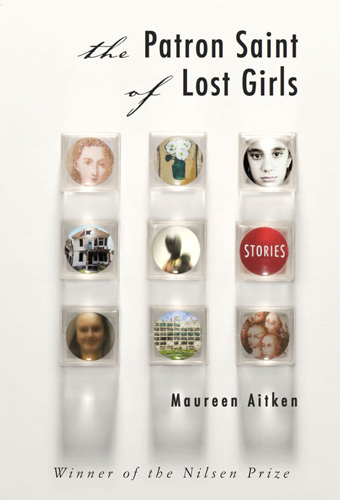‘The Patron Saint of Lost Girls’ by Maureen Aitken
 Maureen Aitken’s linked short stories, The Patron Saint of Lost Girls, is the winner of the 2018 Nilsen Prize, awarded to American writers who have not yet published a novel. The fourteen stories follow Mary, a sometimes artist, struggling through the economic recession in Detroit in the 1970s and 1980s. Told in the first-person point of view, Aitken’s stories are intimately close to Mary’s life and relationships all the while reflecting more broadly on the Midwest. Aitken’s stories are small and intimate but backed by the weight of broader themes: urban decay and what it means to survive as a woman.
Maureen Aitken’s linked short stories, The Patron Saint of Lost Girls, is the winner of the 2018 Nilsen Prize, awarded to American writers who have not yet published a novel. The fourteen stories follow Mary, a sometimes artist, struggling through the economic recession in Detroit in the 1970s and 1980s. Told in the first-person point of view, Aitken’s stories are intimately close to Mary’s life and relationships all the while reflecting more broadly on the Midwest. Aitken’s stories are small and intimate but backed by the weight of broader themes: urban decay and what it means to survive as a woman.
 Maureen Aitken’s linked short stories, The Patron Saint of Lost Girls, is the winner of the 2018 Nilsen Prize, awarded to American writers who have not yet published a novel. The fourteen stories follow Mary, a sometimes artist, struggling through the economic recession in Detroit in the 1970s and 1980s. Told in the first-person point of view, Aitken’s stories are intimately close to Mary’s life and relationships all the while reflecting more broadly on the Midwest. Aitken’s stories are small and intimate but backed by the weight of broader themes: urban decay and what it means to survive as a woman.
Maureen Aitken’s linked short stories, The Patron Saint of Lost Girls, is the winner of the 2018 Nilsen Prize, awarded to American writers who have not yet published a novel. The fourteen stories follow Mary, a sometimes artist, struggling through the economic recession in Detroit in the 1970s and 1980s. Told in the first-person point of view, Aitken’s stories are intimately close to Mary’s life and relationships all the while reflecting more broadly on the Midwest. Aitken’s stories are small and intimate but backed by the weight of broader themes: urban decay and what it means to survive as a woman.
Aitken’s story “The Family Trip” seems at first to be a familiar narrative where Mary’s older sister Meghan struggles with anorexia and the family goes on a road trip to restore normalcy and order. Stories about road trips as family salvation and anorexic young girls can easily be overly familiar, and yet Aitken’s story is far more about the changing Detroit neighborhood and how food is an issue of class. When Meghan and the popular crowd walk down the street, Mary observes the streets and how “constant giggling felt weird in a neighborhood that mixed a Black Power vibe with the Business Dad thing.”
Aitken similarly reminds the reader that food, like housing and who walks the streets, is an economic issue: “The days after payday, Mom cooked in her glory [ . . . ] After the first week, we ate less chicken and more potatoes [ . . . ] At a week and a half, Mom cooked oatmeal for breakfast, canned tuna and peas for dinner.” Aitken utilizes familiar elements to discuss issues of gender and growing up, while also acknowledging that she has written stories for adults, which are ultimately about more than Mary and her relationships. Through Mary’s observations, Aitken provides a view into broader themes of class.
In her shorter pieces, Aitken continues to do the double duty of staying intimate with her characters and experiences, while speaking to larger themes. In “Tainted,” Mary gets called in for jury duty and is questioned by the judge for how suitable she will be to sit on the jury. She narrates a list of robberies. She begins with the man who broke into her parents’ house, thenthe man who stole her backpack. But as the narration continues, there’s the friend who was “murdered by the Oakland County Killer, which was the biggest theft—the theft of life—a girl stolen from her childhood.”
The setting of jury duty allows Aitken to probe into questions of what is a person’s civic responsibility to a state? What are robbery and theft ultimately about? How does growing up in a city amidst crime and violence influence a person? And, when so much is stolen without a thought, how we can still end up with Mary thinking, “My life, my life, you have not forsaken me.”
Though Aitken writes about race more expressly in stories such as “The Leisure Class”—where Mary’s best friend is biracial—in other stories, race hangs in the background or remains noticeably absent. In “The Ways of Accidents,” Mary works as a reporter writing about murders for a 9 a.m. deadline. Aitken provides details about one body down to the icicles on his glasses, but only mentions that he’s white a few pages later. With Mary as such an observant narrator, this reads like an absence, as well as a missed opportunity to say more about the intersections of race and class. How might Mary and her coworkers perceive a white dead man as opposed to a dead man of color? What can these observations then say about race in the Midwest in this decade and today?
Aitken’s strength lies in her ability to manage intercharacter relationships while having those relationships and observations reach beyond the lives of her characters. Ultimately, the bigger problems posed in the stories remain unsolved. That’s because at the heart of each story lies a problem deeper than Mary’s relationship with her sister or her father—not to say that these relationships are not in and of themselves rich. But Aitken poses problems and questions about being a working-class woman and how to survive in a world where there are no easy answers.
The Patron Saint of Lost Girls is a collection that does not seek easy answers but lets a reader linger with the belief that maybe, somewhere out there, there is a patron saint—something powerful and inexplicable—looking after those of us who are lost.
Review by Cheryl Wollner




